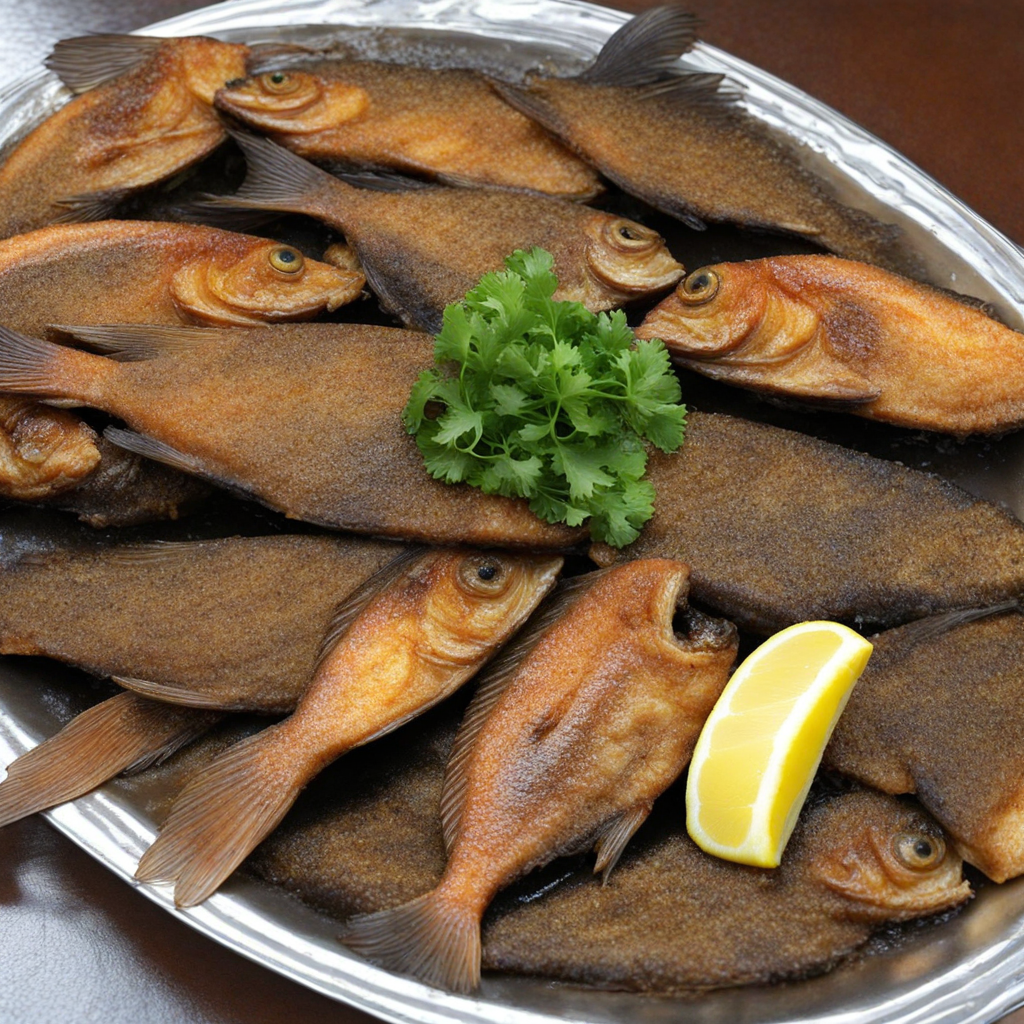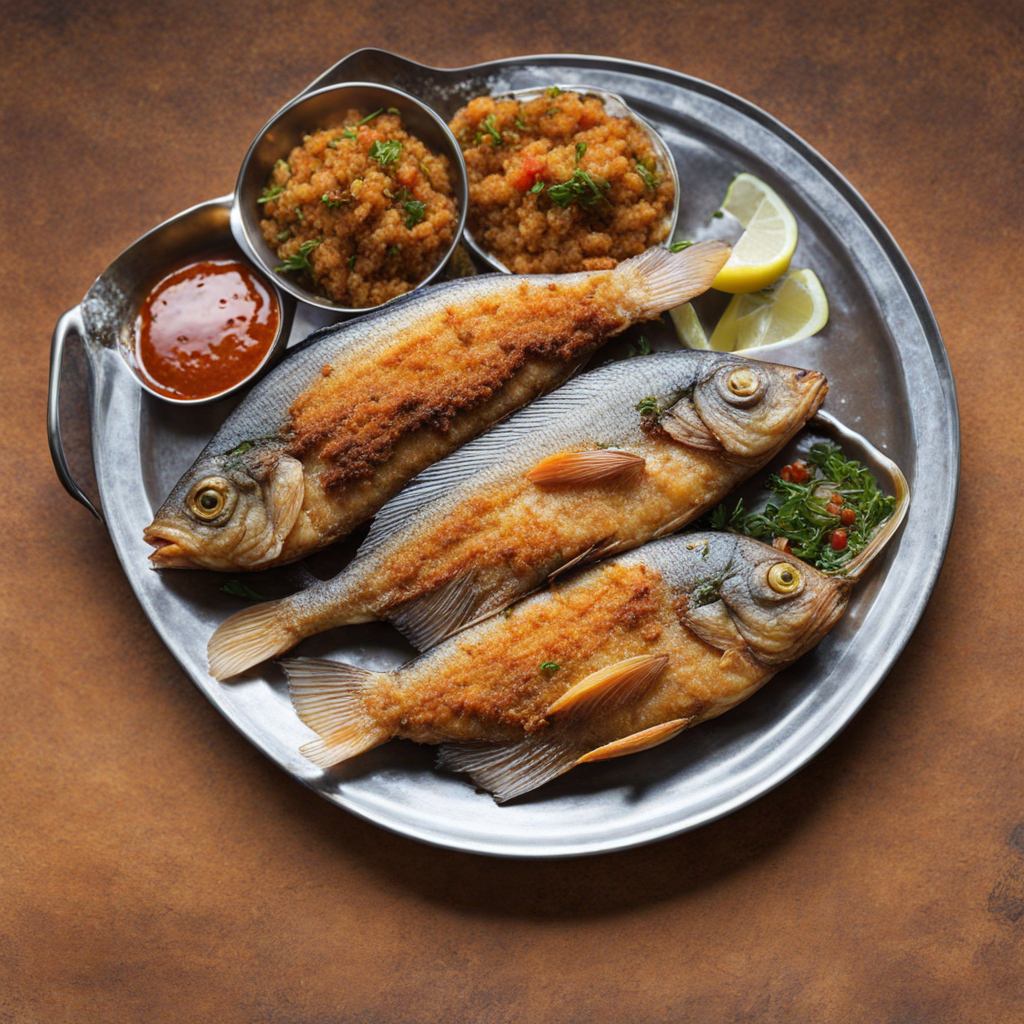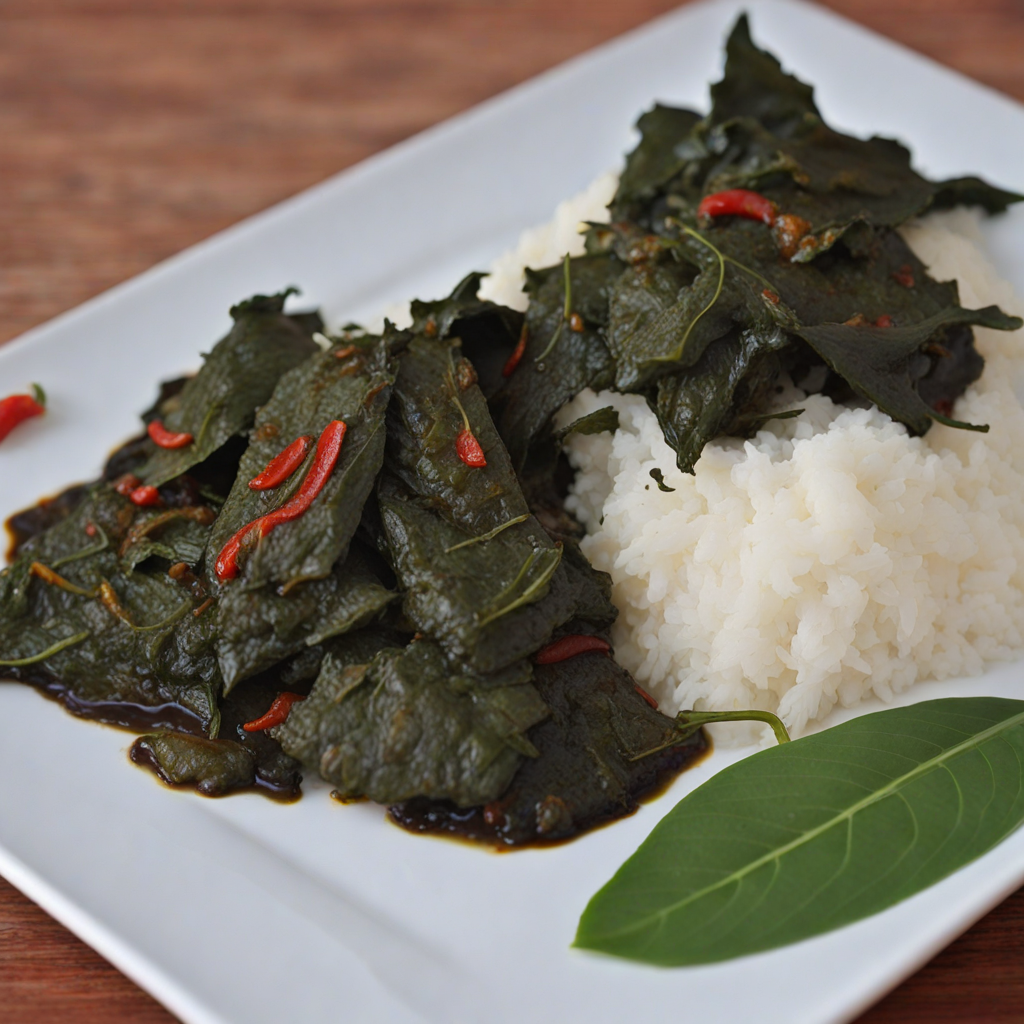Fried Fish
Fried Fish in Sierra Leone is a delightful dish that embodies the essence of West African cuisine, characterized by its vibrant flavors and simple yet effective cooking methods. Typically made using fresh, locally-caught fish such as tilapia or snapper, the fish is first marinated in a mix of spices, often including garlic, ginger, and chili, which infuse it with a rich, aromatic profile. After marination, the fish is coated in seasoned flour or cornmeal, which gives it a crispy texture when fried, creating a beautiful golden-brown crust that contrasts perfectly with the tender, flaky flesh inside. When served, Fried Fish is often accompanied by a variety of side dishes that enhance its flavors. Common pairings include a tangy pepper sauce, which adds a spicy kick, and a side of jollof rice or fried plantains, both of which complement the dish's richness. The combination of textures and flavors makes each bite an experience, as the crunch of the fried coating meets the soft, moist fish, all while being balanced by the heat of the sauce and the sweetness of the plantains. Enjoying Fried Fish in Sierra Leone is not just about the food; it’s about the communal experience that comes with sharing a meal. Often served on large platters, it invites family and friends to gather around the table, savoring the delicious flavors and engaging in lively conversation. This dish is a testament to Sierra Leone's culinary heritage, showcasing the country's abundant seafood and the skillful use of spices, making it a must-try for anyone looking to explore new tastes and cultural experiences.
How It Became This Dish
The Culinary Journey of Fried Fish in Sierra Leone #### Origins and Historical Context Fried fish has long been a staple in the coastal regions of Sierra Leone, a nation rich in both natural resources and cultural diversity. The history of fried fish in this West African country can be traced back to its indigenous communities, who have relied on fishing as a primary source of sustenance for centuries. The Atlantic Ocean, with its bountiful marine life, provided an abundance of fish, allowing local populations to develop distinct culinary practices around this vital resource. The fishing traditions in Sierra Leone can be traced back to the early inhabitants of the region, including the Temne and Limba people, who utilized nets, hooks, and traditional traps to catch fish. The arrival of European traders, particularly the Portuguese in the 15th century, introduced new fishing techniques and methodologies. This interaction not only established trade routes but also led to the exchange of spices and cooking techniques that influenced local cuisine, including the preparation of fried fish. #### Cultural Significance Fried fish holds a significant place in Sierra Leonean culture. It is more than just a meal; it is a centerpiece of communal gatherings, celebrations, and everyday life. In a country where fishing communities thrive, the act of preparing and sharing fried fish is imbued with social and cultural meaning. Festivals, such as the annual Freetown Fish Fest, celebrate the rich maritime heritage and the importance of fish in the local economy. The dish is often served with a variety of accompaniments, including cassava, rice, or plantains, and is typically seasoned with local spices that reflect the country's culinary diversity. The preparation of fried fish varies from region to region, with each community adding its unique flair, be it through marinades, spice blends, or cooking techniques. Fried fish is also a symbol of resilience. In the aftermath of the civil war (1991-2002), communities turned to their traditional practices, including fishing, to rebuild their lives. Women, in particular, played a critical role in this revival, often taking on the responsibility of selling fried fish in local markets. This not only provided a source of income but also contributed to the empowerment of women within their communities. #### Development Over Time The evolution of fried fish in Sierra Leone can be viewed through various lenses – economic, social, and culinary. In the early 20th century, the fishing industry began to modernize with the introduction of motorized boats and improved preservation techniques. This allowed for greater catch quantities and a more vibrant fish market. The introduction of refrigeration changed the landscape of fish distribution, making fried fish more accessible to urban populations. As Sierra Leone's economy grew, so did the culinary landscape. The emergence of urban centers, particularly Freetown, led to a fusion of traditional and contemporary cooking practices. Street food culture exploded, with fried fish vendors becoming ubiquitous in marketplaces, serving quick, affordable meals to locals and visitors alike. This culinary evolution brought with it a new appreciation for fried fish, not only as a traditional dish but also as a vital part of the urban food scene. In recent years, the influence of globalization has also begun to shape the preparation and consumption of fried fish in Sierra Leone. Increased exposure to international cuisines has led to the introduction of new flavors and cooking techniques. While traditional methods remain prevalent, many chefs and home cooks are experimenting with marinades, coatings, and frying techniques inspired by global culinary trends. #### Ingredients and Preparation The preparation of fried fish in Sierra Leone is deeply rooted in tradition. Typically, local fish varieties such as bonga (Sardinella) or snapper are chosen for frying. The process begins with cleaning and gutting the fish, followed by marinating it in a mixture of spices, which may include garlic, ginger, chili, and local herbs. The marination process helps to infuse the fish with flavor, with some families passing down secret recipes through generations. Once marinated, the fish is coated in seasoned flour or cornmeal before being deep-fried until golden brown and crispy. The frying method can vary, with some cooks opting for shallow frying in vegetable oil, while others prefer deep frying for a more uniform cook. The result is a dish that remains juicy on the inside while boasting a satisfying crunch on the outside. Accompaniments play a crucial role in the enjoyment of fried fish. In coastal areas, it is common to pair fried fish with a spicy pepper sauce, often made from local ingredients such as chili peppers, onions, and tomatoes. This sauce adds a layer of heat and complexity, enhancing the overall flavor profile of the dish. Fried fish is also frequently served alongside steamed rice, boiled plantains, or fried yam, creating a hearty meal that satisfies both the body and soul. #### Contemporary Trends and Globalization As Sierra Leone continues to navigate the complexities of modernity, the future of fried fish is also evolving. The culinary landscape is becoming increasingly influenced by health consciousness, with a growing number of people seeking healthier cooking methods. This shift has led some cooks to explore alternatives to deep frying, such as grilling or baking, while still retaining the essence of traditional flavors. Moreover, the rise of social media and food blogging has allowed Sierra Leonean cuisine, including fried fish, to gain international recognition. Chefs and home cooks are showcasing their culinary heritage, sharing recipes, and engaging with a global audience. This newfound visibility is fostering a sense of pride in Sierra Leonean food culture and encouraging the exploration of traditional dishes. In conclusion, fried fish in Sierra Leone is not just a beloved dish; it is a reflection of the nation's rich history, cultural significance, and ongoing evolution. From its origins in indigenous fishing practices to its role in contemporary culinary trends, fried fish remains a vital part of Sierra Leone’s identity. As the country continues to embrace both tradition and innovation, fried fish will undoubtedly retain its status as a cherished culinary symbol for generations to come.
You may like
Discover local flavors from Sierra Leone







